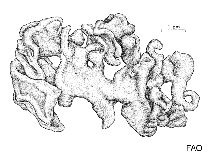Codium edule P.C. Silva
Branched sea cushion| Native range | All suitable habitat | Point map | Year 2050 |

|
| This map was computer-generated and has not yet been reviewed. |
| Codium edule AquaMaps Data sources: GBIF OBIS |
Upload your photos
Google image | No image available for this species;
drawing shows typical species in Codiaceae.
Google image | No image available for this species;
drawing shows typical species in Codiaceae.
Classification / Names Common names | Synonyms | CoL | ITIS | WoRMS
Bryopsidophyceae | Bryopsidales | Codiaceae
Environment: milieu / climate zone / depth range / distribution range Ecology
Sessile; depth range 2 - 48 m (Ref. 80758). Tropical
Distribution Countries | FAO areas | Ecosystems | Occurrences | Introductions
Indian Ocean: in Maldives; Pacific Ocean: from Taiwan to Papua New Guinea, including Spermonde Archipelago, Indonesia and Federated States of Micronesia, east to the Hawaiian Islands.
Length at first maturity / Size / Weight / Age
Maturity: Lm ? range ? - ? cm
Short description Morphology
Thallus intertwined green to greenish brown, forming a spongy mass. Branches cylindrical, 3 to 7 mm in diameter, attached to one another at any point by small cushion-like rhizoidal structures. Branching dichotomous to subdichotomous, forming angles of more than 45° but less than 90°. Filaments of the medulla 42 to 69 μm wide, separated from the utricles by deep constrictions. Utricles club-shaped, cone-shaped, or cylindrical, slightly tapering towards the base with rounded tips; some utricles with slight swelling just below the apex; utricles 200 to 460 μm in diameter at the thickest portion, and 800 to 1 070 μm in length. Amorphous clumps up to 5 cm in diameter (Ref. 80758).
Used as food by humans; commonly sold fresh in the markets in Northern Luzon, Philippines (Ref. 80758). Maximum depth from Ref. 102150. Attached to coralline or sand-covered rocks in lower intertidal to subtidal areas at depths of 1.8 to 4.6 m (Ref. 80758).
Life cycle and mating behavior Maturity | Reproduction | Spawning | Eggs | Fecundity | Larvae
Main reference
References | Coordinator | Collaborators
Guiry, M.D. and G.M. Guiry. 2009. (Ref. 80701)
IUCN Red List Status (Ref. 130435)
CITES status (Ref. 108899)
Not Evaluated
CMS (Ref. 116361)
Not Evaluated
Threat to humans
Harmless (Ref. 80758)
Human uses
Fisheries: commercial
| FishSource |
Tools
More information
Internet sources
BHL | BOLD Systems | CISTI | DiscoverLife | FAO(Publication : search) | Fishipedia | GenBank (genome, nucleotide) | GloBI | Gomexsi | Google Books | Google Scholar | Google | PubMed | AlgaeBase | Tree of Life | Wikipedia (Go, Search) | Zoological Record
Estimates based on models
Preferred temperature
(Ref. 115969): 24.7 - 28.9, mean 27.5 (based on 230 cells).



